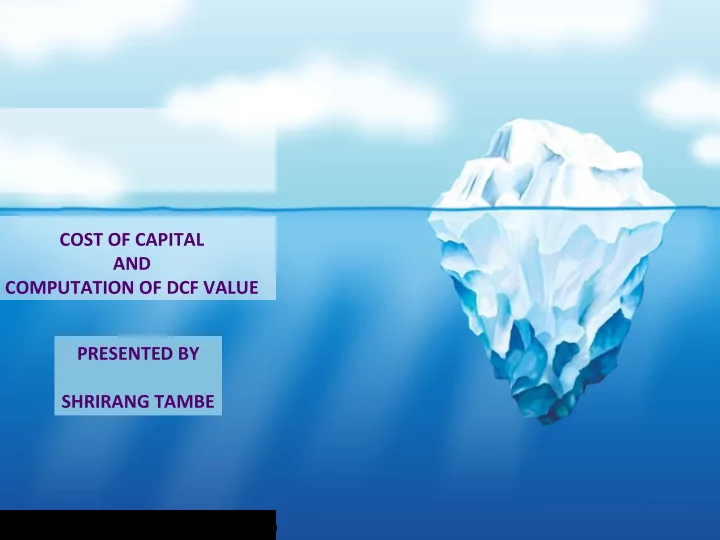

COST OF CAPITAL AND COMPUTATION OF DCF VALUE PRESENTED BY SHRIRANG TAMBE www.oureacapital.com
VALUATION – MANAGEMENT’S DREAM OF ‘APPLE’ VALUE ! 2
Valuation – what does industry players look for? The process of determining the value of an asset or company The act or process of assessing value or price; an appraisal. Intrinsic value: The actual value of a security as opposed to its market price or book value How industry views it… Perceived value for an asset or business which is agreeable to both seller and buyer at negotiated terms in the framework of valuation arrived and as on that 3 particular market scenario
Its more of a science of judgement than a pure science! Actually composition practiced in the industry !! Methods + judgement + Experience = VALUATION FRAMEWORK 4
COST OF CAPITAL 5
COST OF CAPITAL – ONE OF THE MOST CRITICAL INPUT FOR DCF • It is the cost at which the business and the growth gets financed • Different for each sector, different for each of the companies within a sector • A moving part – fluctuates on account of macro and micro economic changes 6
COMPONENTS OF COST OF CAPITAL • Coupon/interest rate is applicable on the fixed yield instrument is considered • The tax shield on account of such coupon and interest is factored in FIXED YIELD INSTRUMENTS E.g. COST OF DEBT (Kd) = Interest rate * (1- Tax Rate) • Multiple methods available to determine cost of equity • Represented by Ke • The key method to find cost of equity is Capital Asset Pricing Model (CAPM) EQUITY • Other method available is Arbitrage Pricing Theory (APT) • CAPM considers the following parameters for its computation • Rf – Risk Free Rate of Return • Beta – asset specific risk 7 • Rm – Market Return
UNDERSTANDING COST OF EQUITY Ke = Rf + Beta * (Rm – Rf) • Rf – Risk Free Return Why do we start with Rf? What is the rationale behind it? • What is the correct benchmark why? • Which market do we benchmark? Rm – Market Return • What should be the period of considering the returns? • What does it signify? Beta – Risk Parameter • What does it factor in? • What are the underlying fundamental assumptions which are not very explicit? • Other Premiums Do we further add risk premiums? • How do we decide? 8 • E.g. Liquidity premium, sector premium, industry cycle premium
CALCULATION OF WACC - Weighted Average Cost of Capital (WACC) pertains to blended cost of financing the business - Blending debt with equity leads to optimising cost of financing – but only upto a point ! - Leverage magnifies return on equity – both positively and negatively Optimum point Cost of debt WACC CALCULATION OF WACC WACC is calculated by considering cost of each of the financing options in proportionate to its weight in total financing of a company 9 WACC = D/(D+E) * Kd + E/(D+E) * Ke
DETERMING EQUITY VALUE BY DCF 10
DISCOUNTED CASH FLOW VALUATION - Difference between Pre Money and Post Money Valuation - Methods of determining free cash flows • Determines cash flow available to all financers of capital • Discounted by WACC • Determines cash flow available to all equity shareholders • Discounted by Cost of Equity FCFF – Free Cash Flow to the Firm ¦ FCFE – Free Cash Flow to Equity To arrive at FCFF… To arrive at FCFE… Adjust Post Tax EBITDA/Operating Profit with Adjust Post Tax EBITDA/Operating Profit with a)Change in Working capital a)Change in Working capital 11 b)Capital Expenditure b)Capital Expenditure c)Debt payments
TERMINAL VALUE 12
DETERMINING EQUITY VALUE CALCULATION OF ENTERPRISE VALUE • Calculate FCFF and terminal Value • Discount it with WACC Long Term Debt Investment Why this ? PRESENT EQUITY VALUE 13
THANK YOU SHRIRANG TAMBE shrirang.tambe@oureacapital.com 14
Recommend
More recommend